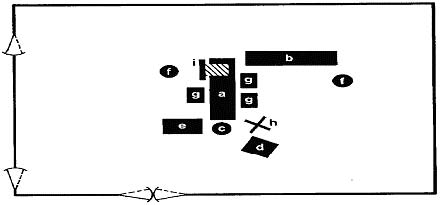Introduction to the Operating Room
LESSON 1: ORIENTATION
Exercises: Lesson 1
EXERCISES, LESSON 1
INSTRUCTIONS: Answer the following exercises by marking the lettered response that best answers the exercise, by completing the incomplete statement, or by writing the answer in the space provided at the end of the exercise.
After you have completed all the exercises, turn to "Solutions to Exercises" at the end of the lesson and check your answers. For each exercise answered incorrectly, reread the material referenced with the solution.
1. When the electrical fixtures are installed in a surgical suite, the AC and DC outlets
are marked for identification in what way?
a. Painting signs beside them.
b. Installing colored lights adjacent to them.
c. Installing pilot lights into the switches.
d. Making AC outlets of one color and shape and DC outlets of another.
e. Constructing them with interlocking switches.
2. Outlets and switches that are not explosion-proof and are located in areas where
flammable agents are to be used should be mounted five feet from what point?
a. Above the floor.
b. Below the ceiling.
c. The head end of the OR table.
d. The top of the gas anesthesia apparatus.
3. Why is the humidity in the operating room maintained between 55 and 60
percent?
a. To provide maximum comfort to personnel.
b. To provide maximum comfort to the patient.
c. To reduce the explosion hazard.
d. To promote sterile conditions.
4. The floor should be grounded in each individual operating room. The electrical
circuits supplying current for lighting and wall outlets should be:
a. Grounded.
b. Ungrounded.
c. Alternating current only.
d. Direct current only.
5. In preparing an operating table for surgery, the casters must be:
a. Oiled.
b. Packed.
c. Free-moving.
d. Locked.
6. The Mayo stand is constructed with a detachable tray in order to facilitate:
a. Passing the tray to the surgeon.
b. Sterilization of the tray.
c. Setting up the tray with sterile goods.
d. Moving the stand into position for surgery.
7. The table used for holding sterile goods, other than those for immediate use
during an operation, may be appropriately referred to as the _______ table.
a. Back.
b. Mayo.
c. Prep.
d. Anesthetist's.
8. The electrode tip for the electro surgical unit is set up by the:
a. Surgeon.
b. Circulator.
c. Anesthetist.
d. Scrub.
9. Possible sources of contamination during a patient's surgery include:
a. Only the surgeon.
b. Only the circulator.
c. Only dust in the air.
d. Only instruments used in the wound.
e. All of the above.
10. Supplies for the "sterile" team members are provided by whom?
a. Scrub.
b. Circulator.
c. Surgeon.
d. Anesthetist.
11. A circulating specialist is passing a sterile area; he should face the sterile area in
order to:
a. Observe whether he has provided all needed items for the set-up.
b. Ensure that he doesn't touch the setup.
c. Facilitate communication with the scrub specialist.
d. See that the scrub has done the draping properly.
12. A specialist is cleaning floors in the surgical suite using the mop-and-pail method.
He should:
a. Soak mop heads in germicidal solution between periods of utilization.
b. Ensure that mop heads are laundered no less than once a week.
c. Use a fresh germicidal solution.
d. Change mop heads and germicidal solution daily.
13. If performed in the correct sequence, which operation is performed LAST?
a. Wheel furniture over germicide-soaked mat.
b. Wipe furniture down with a germicidal solution.
c. Remove solution from floor with wet-vacuum pickup.
d. Wheel furniture into the hallway.
14. What solution is generally used for dusting in the surgical suite?
a. Ten percent formalin solution.
b. Normal (0.9 percent) saline.
c. Germicide.
d. Distilled water.
FOR EXERCISES 15 THROUGH 22. The drawing below depicts an appropriate way of grouping furniture and equipment for a general surgery operation. The item labeled c is the anesthetist's stool.
15. What equipment or piece of furniture is a?
___________________________________
16. What equipment or piece of furniture is b?
___________________________________
17. What equipment or piece of furniture is d?
___________________________________
18. What equipment or piece of furniture is e?
___________________________________
19. What equipment or piece of furniture is f?
___________________________________
20. What equipment or piece of furniture is g?
___________________________________
21. What equipment or piece of furniture is h?
___________________________________
22. What equipment or piece of furniture is i?
___________________________________
Check Your Answers on Next Page


